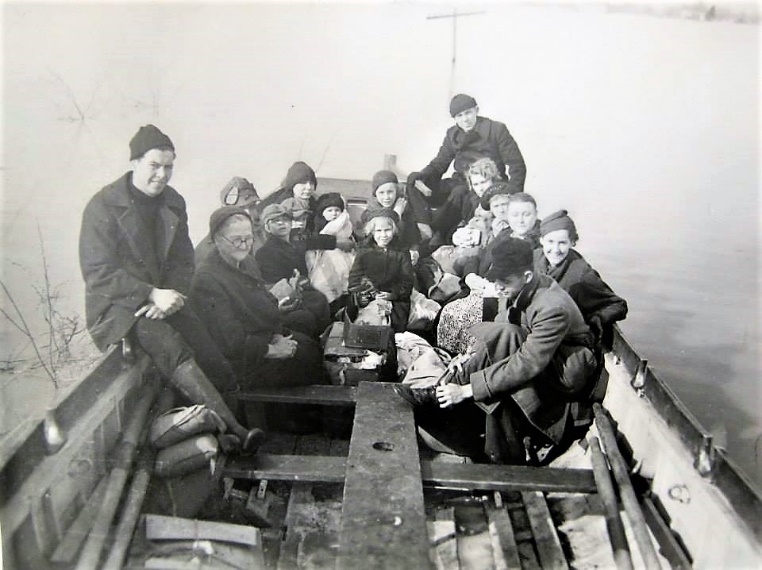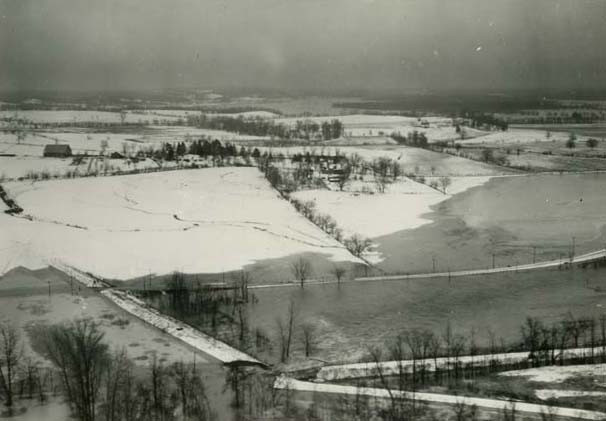SHAWNEETOWN, BEGINNING AND FLOODS
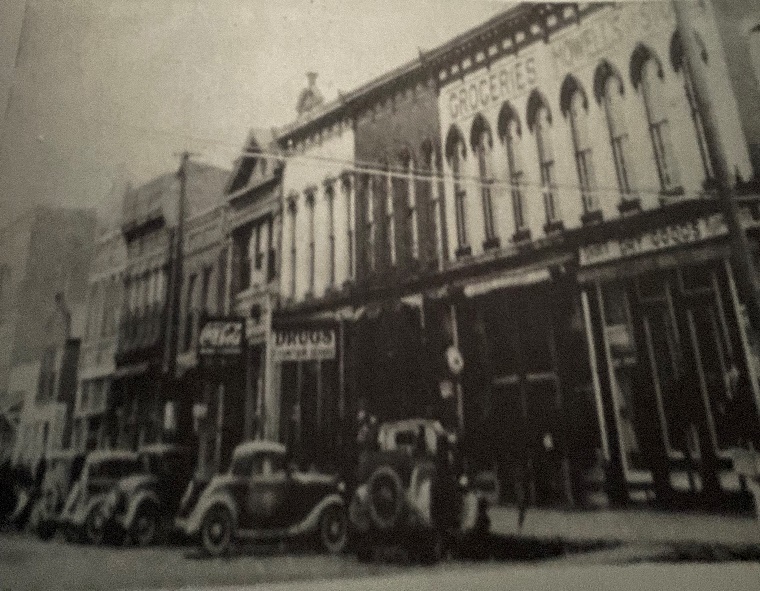
This is a picture of the business district in the original Shawneetown, now known as Old Shawneetown,
before they moved the whole town about three miles up the hill to the west. I found this picture in Amazing Shawneetown, A Tale of Two Cities, by Lucille Lawler, 1985.
You have lived in the same area all your life and thought you knew almost everything about it, but while I was writing about the 1937 flood, I discovered so many interesting facts about Shawneetown, Illinois, that I just kept searching for more. In case you have never been there, take Rt. 13 east as far as you can go. Right before you cross the bridge to Kentucky, you are in Old Shawneetown. I’ll explain the difference in a minute.
Shawneetown was initially established around 1748-1758 by the Pekowi band of the Shawnee while Peter Chartier was the chief. Peter was a fur trader of mixed heritage, French and Shawnee.
The original name was Shawano town. I was watching “Legends and Lies: The Real West,” the other night, and there was a show about Daniel Boone and the Shawnee. They were spread over a large area from the Atlantic to the Mississippi. I thought they just lived around here because of Shawneetown and the Shawnee National Forest. But, no. And, due to the Indian village there, there are ancient Native American burial grounds in the vicinity. In the Handbook of Old Gallatin County, edited by Jon Musgrave, you can find the locations, some being along the Saline River, on the Gallatin-Hardin County line, and one five miles north of Shawneetown. Actually, Musgrave’s handbook is a wealth of info. However, Christy Short doesn’t think these sites are open to the public.
By the 1780’s, after the Revolution, Shawneetown was already an important US government administrative district for the Northwest Territory and was considered the gateway to Illinois for settlers from the east. In 1803, Lewis and Clark stopped there on their way to Fort Massac, which is still there on the edge of Metropolis but somewhat diminished, before heading further west. The fort has a nice museum, also. In 1804, Shawneetown just had a few log cabins. It was finally surveyed and platted as a town in 1810, mainly due to its close proximity to salt springs west of Shawneetown in Equality in Saline County. In fact, in the same year, 6,000 bushels, or 300,000 pounds, of salt were shipped from this new town. It takes 75 gallons of water to make a bushel of salt through boiling and evaporation.
I learned about these bushels of salt from The Comet and the Steamboat by S. M. Tolley. He also told the story of the infant, Alexander, whose father was Dr. John Reid. The story goes that his mother was alone with the babe, and she had him all cleaned and fancied up, when some natives entered her home. A young mother with her own infant on her back, proceeded to look at the shiny baby in its cradle and declared, “Me swap.” And she did swap. Alexander’s mother was beside herself when her husband arrived home, but he had a solution. He told his wife to clean up the dirty little baby left in their care and put some new clean clothes on him. They then went to the camp and showed the fresh baby to the other mother who agreed to swap back. I guess no harm done!
Tecumseh was the great leader of the Shawnee. There is a statue of him at the 105 acre Glen O. Jones Lake in Saline County south of Harrisburg, a good place for fishing and camping. During the War of 1812, Tecumseh was an officer in the British army and was considered a deathly foe in the Northwest Territory. General William Henry Harrison was a General in the US Army. At the Battle of the Thames (not in England), Tecumseh was killed on October 5, 1813. Harrison went on to become the ninth President in, 1841. It seems that at his inauguration, a cold and wet day, he addressed his fellow men without a hat then kept his wet clothes on for the following receptions. He caught a cold and then pneumonia and died with the shortest term, thirty-two miserably sick days.
Anyway. The US Congress began to see the profitability of this Shawneetown place in the form of rents, beginning in 1811. In 1814, Shawneetown became the first incorporated municipality in the Illinois Territory when chartered by the Territorial Legislature on Dec 9, 1814, before Illinois even became a state in 1818. Also in 1818, the federally owned salt wells were turned over to the state. It was often the first stop for immigrants headed west. And here we are, right beside it. We know that Saline County was named for its salt, but who knew about salty Shawneetown?
Salt was so important that Daniel Boone and his men would hike fifty miles to a salty creek and boil it down to make thousands of pounds of salt to carry back to the fort. And that is how he was kidnapped by the Shawnee!
Shawneetown was also a trading and financial center. John Marshall had arrived in this new country in 1801 from Ireland. He worked his way west while farming, and running a store, until in 1804 he heard about Shawneetown and took off. He worked in the “Salines,” as they were dubbed, and built a log cabin. He left the Salines, and built a two-story frame house, on the riverbank, where he opened the first bank in the Illinois Territory. You can see it in the picture next to the brick house they built later, which was the second brick house in town. The front of the houses face the river. As of yet there was no levee.
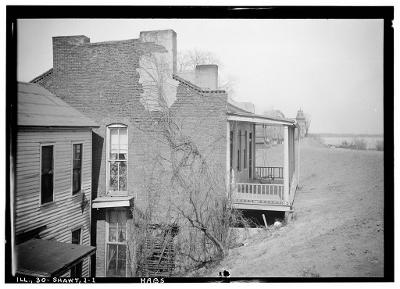
Here we see the John Marshall original frame bank with the new one beside it on the riverbank. No levee yet.
This first bank in Illinois Territory was chartered in 1816 and was known as the first territorial Bank of Illinois at Shawneetown. And again, here we are right beside it. The new brick house was built and competed in 1822, and the bank was in the basement. There was a hole in the parlor, or banking room, floor covered with a grate about one foot by one foot in size. Here people dropped their gold and silver to a barrel in the basement, as they had no minted coinage or paper money yet. A guard/cashier, John Reeves, would be there all night with his gun. This bank did, later, print paper money. In 1837 it became known as the State Bank of Illinois at Shawneetown.
In 1825, Chicago made its first request for a loan from the Shawneetown Bank. According to Lucille Lawler’s book Amazing Shawneetown, a Tale of Two Cities, June Rowan’s grandfather was a director of John Marshall’s bank. She told the story of four men riding horseback to Shawneetown from Chicago who requested a loan of $10,000 (or $30,000). Everyone’s tales differ a little, and many people over the years thought it just that, a tall tale. Chicago was incorporated as a town in 1833, then when the population reached 4,000, in 1837, they became a city. So Chicago needed help in getting their new town on the way. However, the bankers in Shawneetown, almost the whole length of the state away, felt Chicago was too far away from Shawneetown to amount to anything, and it wasn’t even on a river. They denied the loan. However, Musgrave mentions that in the twentieth century a trove of old documents was found that was thought to have burned in the great fire. Among them was a letter dated July 5, 1838, from the Shawneetown Bank in which they deny the loans, a larger one and a smaller one. This explains the different amounts and corroborates the story. But, no dollar amounts were mentioned. Ms. Short disputes some of this as tales to add interest. She can’t find any proof of an amount. I don’t know how to explain the difference between 1825 and 1838.
In 1839, a much fancier bank was built thinking to give competition to the old one. Actually, they just moved the bank from John Marshall’s brick house to the new bank, so there wasn’t any competition. It was built with Greek revival architecture, big steps rising to big columns. It is still there and is on the National Registry of Historic Places as the Marshall Museum.
Then they demolished the original, historic brick house-bank on the bank of the river (two different banks there, a little confusing) due to serious deterioration and built a replica. They had saved and numbered the bricks, floor boards, and as many other parts as could be repurposed and used them in the new construction (in picture) which began in 1973. It is now a museum-the John Marshall Home Bank Museum. You should really take a drive to these two towns, check out the sites, and then go to the museum. Hours are 1PM to 4PM on the first and third Sundays of the month, May through October. If you go, notice the bricks and stones on the levee, which were original from the first brick bank/house. They didn’t want to take them up for fear of weakening the levee.
Here we see the reconstruction of the Shawneetown bank with the hole in the floor for deposits. You can see the levee behind it (or in front of it). The chimney was from the log cabin after it was moved in 1981.
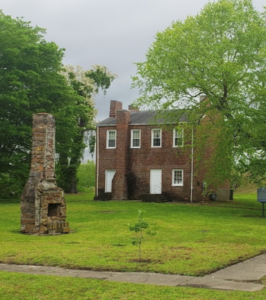
The museum is full of many antiques, only a few of which are original items, and are on display, one being the oldest safe in Illinois, made in 1825. It is about three feet tall by two feet on the sides. There are big studs from spikes driven in on all four sides. I try to think why that is important for the inside of a safe, but it’s not coming. Christie Short told me the story about this safe being borrowed by a Chicago bank in 1918 to display and help celebrate the Centennial of Illinois statehood. The heirs then consented to allow the safe, other artifacts, and family portraits to be loaned to the Chicago Historical Museum. The Marshall descendants had asked many times for the return of the valuable articles, but were told that the Chicago Museum had been given the antiques, and so they refused to return them. Over the years, Shawneetown organized the Gallatin County Historical Society. And finally, after the involvement of many officers of the society as well as Congressman Paul Simon, they were able to bring the items home where they are now in the museum in Shawneetown.
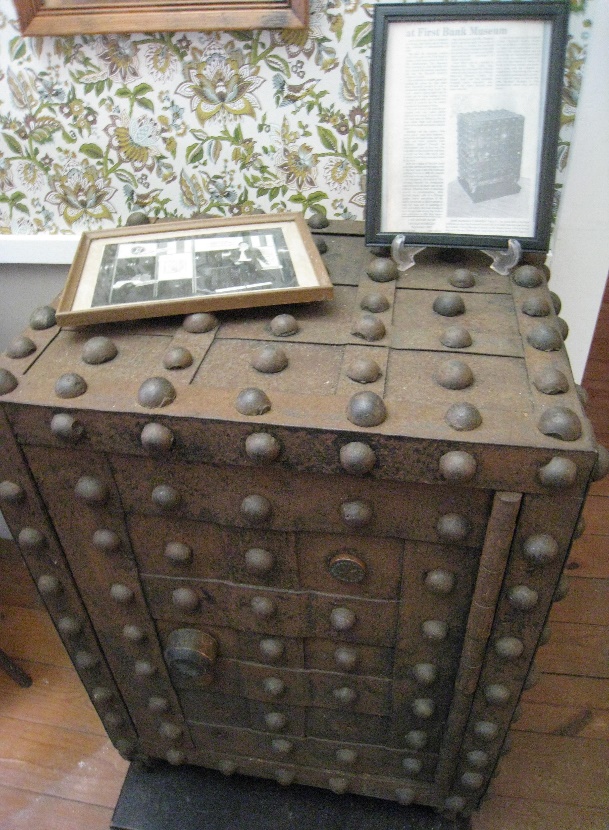
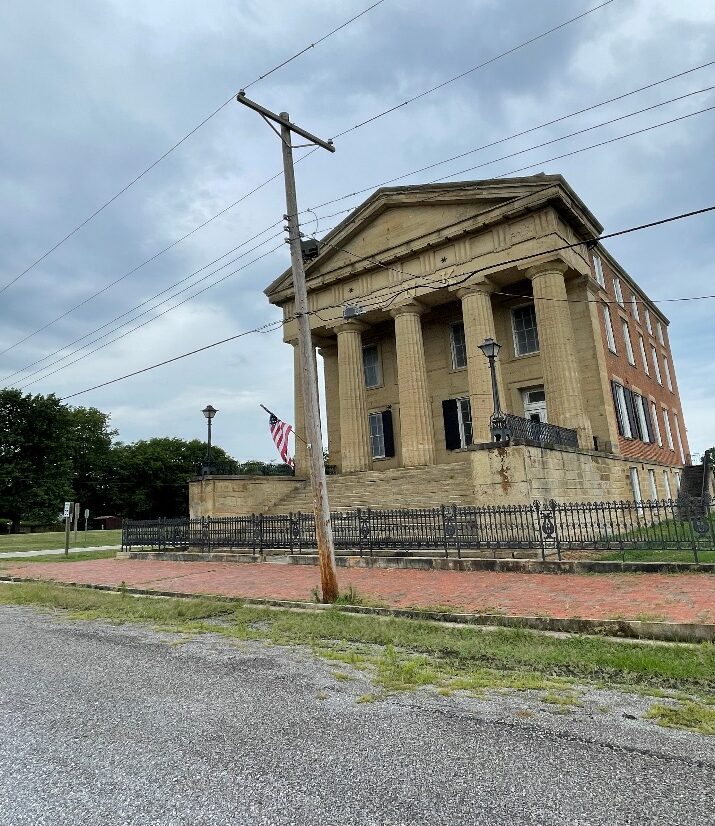
On May 7, 1825, the Marquis de Lafayette visited Shawneetown, and his visit was welcomed with and commemorated by a most noble speech full of gratitude for his assistance in the Revolution. The Honorable Judge Hall had the honors. This was certainly a well-traveled route, and General Lafayette’s visit again acknowledges its importance. By now it was considered the financial capital of the state.
Another important visitor came to town on September 5, 1840-Abraham Lincoln, who was rumored to have stayed in the John Marshall Bank/house. He may have slept in one of the upstairs bedrooms. But Mrs. Patrick said he wouldn’t sleep in the bed. He slept in a chair. Ms. Short can find no documentation of this and adds another tale. She says he might have stayed at the Crenshaw house (the “old slave house”) down on Route 1 near Equality. I was able to go there several years ago, but now it is not open to the public.
Interestingly, or naturally, all the earliest settlements in Illinois were along rivers. Golconda and Shawneetown were on the Ohio. Cairo on the confluence of the Ohio and the Mississippi. Kaskaskia, the first capital, is on the Mississippi. Some of the little French hamlets on the Mississippi dispute Shawneetown’s claim as first. But, were they incorporated? That seems to make a difference. So really, who would have thought Chicago stood a chance.
Shawneetown has suffered through many floods; 1813, 1832, 1847, 1853, 1858. Finally, they slowly began work on a levee with the help of the state. Slowly being the key word, so that in 1867, when the next flood came, the town was again submerged. More bonds were issued until finally the levee was completed. They thought they were safe until, in 1875, when the next flood broke the levee. It was repaired, but in 1882 and again in 1883 the town was flooded. Then came another flood in 1884 which was higher. The levee broke again, and the flood carried over 100 houses down the river. Steamboats could travel down the streets. Isn’t it time to move on? Not yet, but they did decide to raise the levee one foot higher than the flood of 1884, One foot? Really? But it was completed; four and one half miles long, twelve feet wide on top. But it was already doomed. It was too steep on the outside and too full of sand, and no rip-rap.
The citizens felt very secure in 1898 when another great flood came their way. So secure that they just went upstairs to ride it out. They had a good levee. Hmmm. On April 4, 1898, the St. Louis Post Dispatch told the story of this deceiving levee. John Branch, a railroad conductor whose wife’s relatives lived in Shawneetown, had been in charge of carrying 425,000 feet of loamy dirt from Sand Cut, back in the hills, for the Baltimore and Ohio Southwestern Railway which held the contract. It wasn’t the best dirt for a levee-too much sand, but was the best they could find. I think Tom told me that’s why the levee still seeps today. I would assume this is the levee built after the 1884 flood.
The newspaper interviewed Mr. Branch. He said the levee he built surrounded the town on three sides, starting in the hills on one side about a mile and a half back from the river, then up to the river and ran along the bank for a mile, then back to the hills. But, alas, the levee broke again. Many people drowned. The only part standing was a section rip-rapped by the government. Mr. Branch immediately left for Shawneetown after the flood to search for his wife’s parents, brother, and aunt, but didn’t think there was much hope.
When the flood of 1937 came, they had their levee. But someone knew it was about to blow, probably because of all the leaks seeping water into the town. The citizens are in a panic, worrying about their homes again being destroyed or washed away or themselves drowning. This was not a far-fetched scenario. So, the powers that be chose a rural area along the south levee and put the dynamite to it. The ensuing floodwaters again destroyed the town.
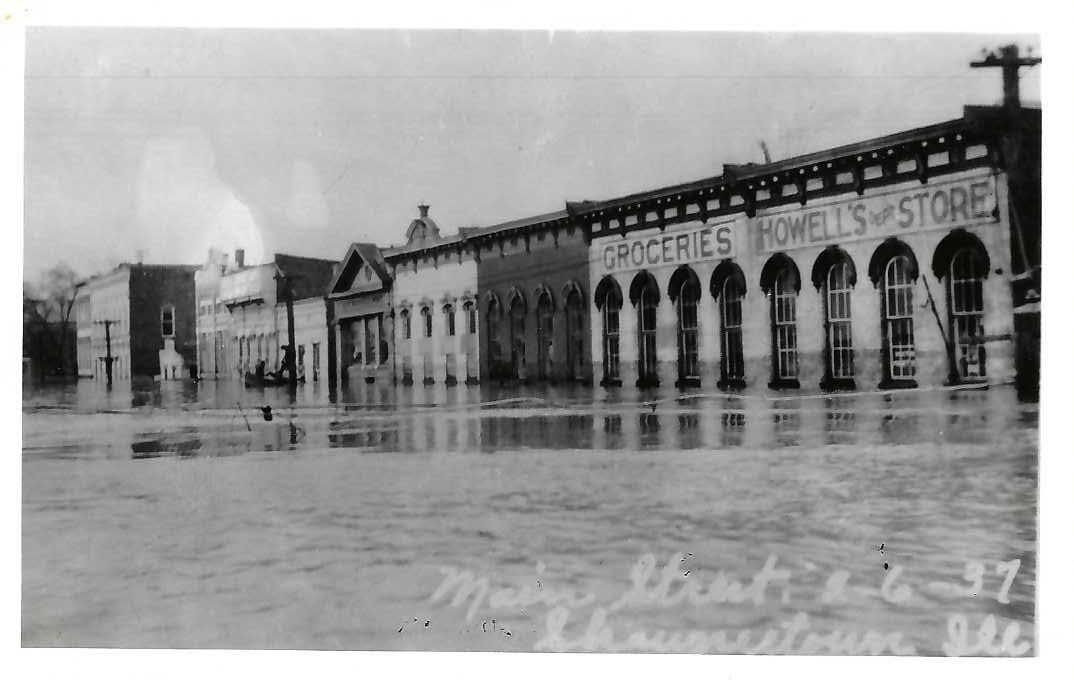
The government thought they had sunk enough money into this flood-prone disaster area. They decided to move the town, finally. Washington, D.C. and New Shawneetown are the only towns in the United States platted by the US government. All you had to do was exchange your old lot in Old Shawneetown for a new one. Everyone did not accept this offer. Somewhere less than 200 residents stayed. Larry’s Uncle Tom Harmon’s grandfather received a lot for his home and his store on the hill of New Shawneetown. You can still see “Harmon’s” on the front of the store. The move began in 1938 but lasted several years. The federal government still owns a lot of property in Old Shawneetown, and the population is now about 150 people who cannot get flood insurance. Tom says Old Shawneetown can still get water knee high inside the levee when the river is up; it seeps in through holes. And the water can get to within one foot of the top of the new levee.
There is still a small main street, the two old banks, the old Catholic Church, and some houses. As we drive through New Shawneetown, I like to guess which houses were moved. Some people advocate that the people living there should also be relocated. I guess that is on them.
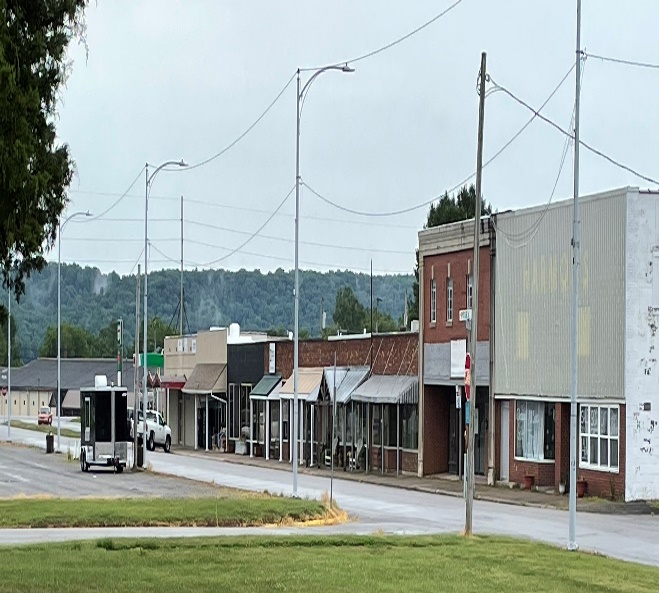
The current levee runs about one half mile along the river but is six to eight miles in total length. After it leaves the levee, it circles around and has wings.
Another interesting fact is that Gallatin County was named for Albert Gallatin, an immigrant from Switzerland, who became Secretary of the Treasury under Thomas Jefferson.
I had a lot of help with this info including Larry’s Uncle Tom Harmon; Lucille Lawler in her book mentioned above; S.M. Tolley and his book also mentioned above; Jon Musgrave in his handbook mentioned above; Christy Short, curator and historian at the museum; Janet Householder, guide at the museum; and Diane Drone Patrick, the upstairs guide when we were there. Tom told me to contact Christy because she was the complete source on Shawneetown. She sure was. Thanks to all.
